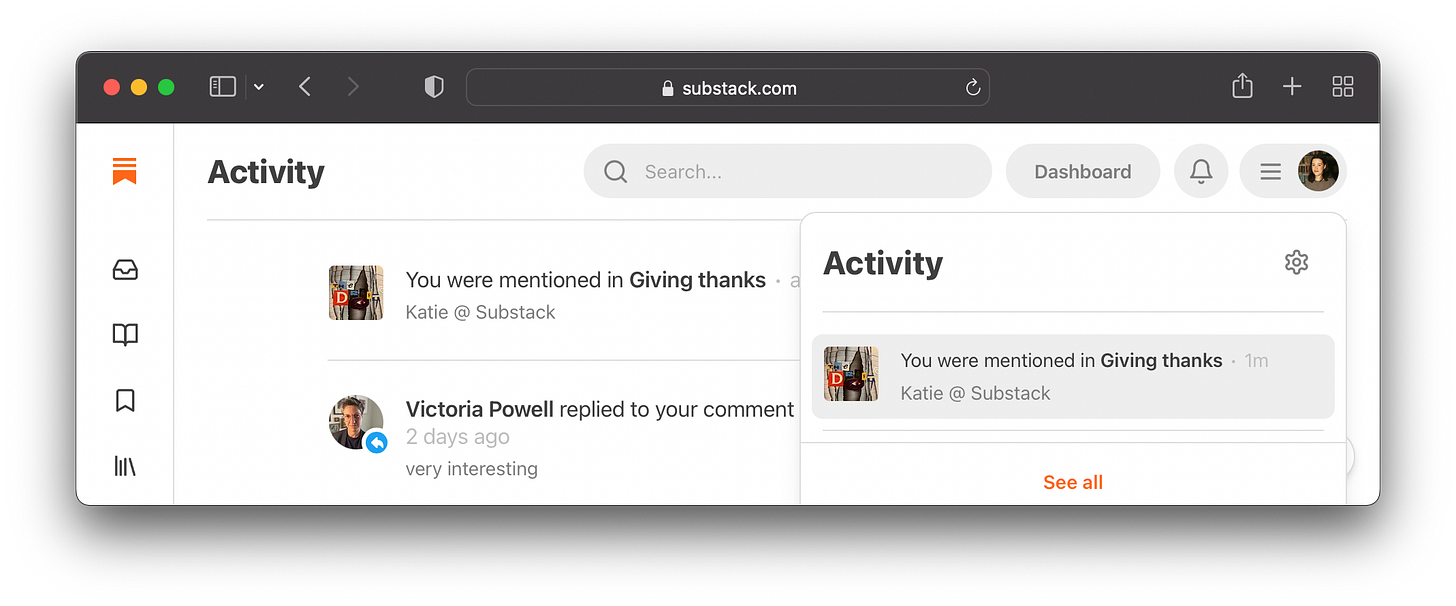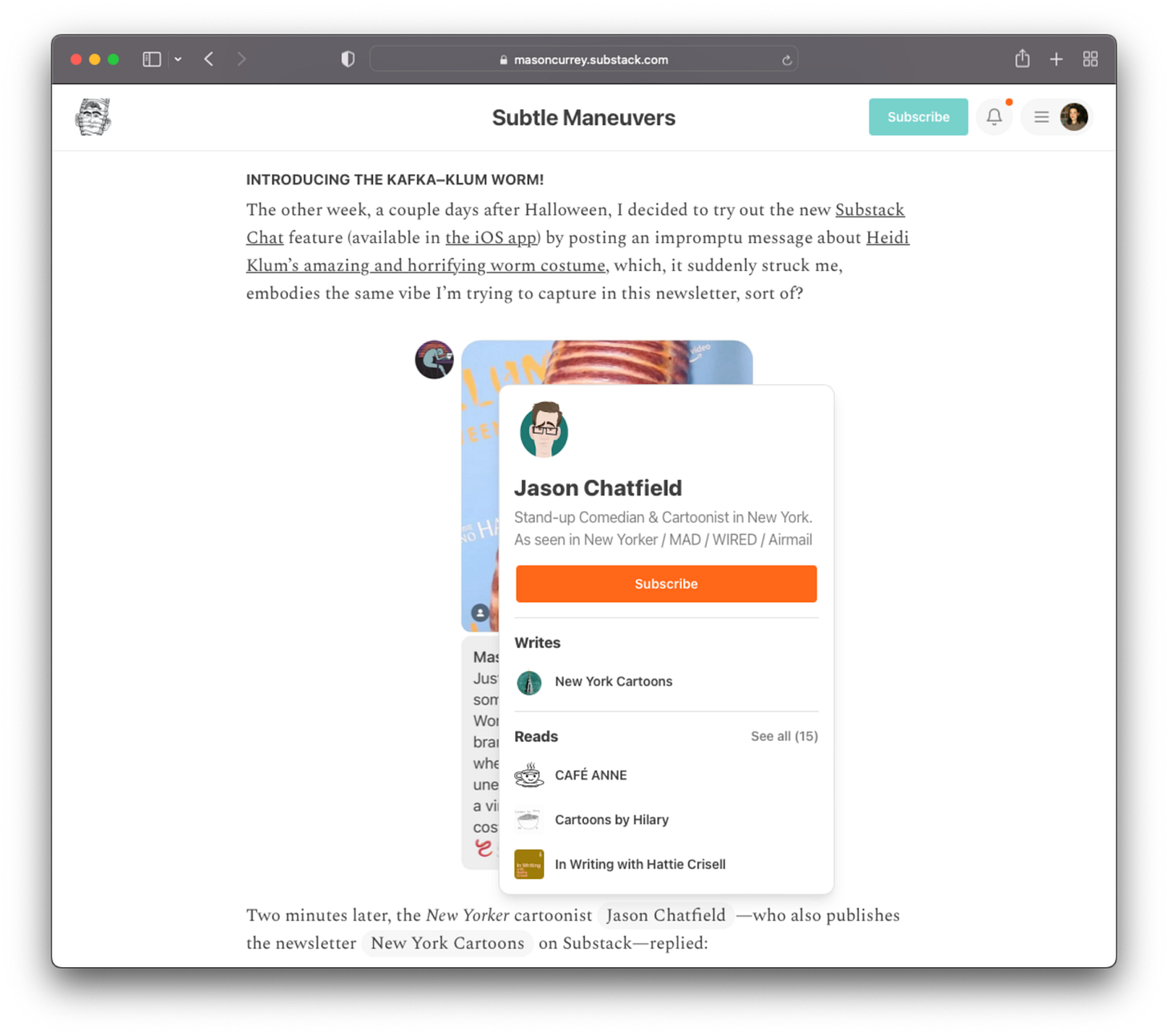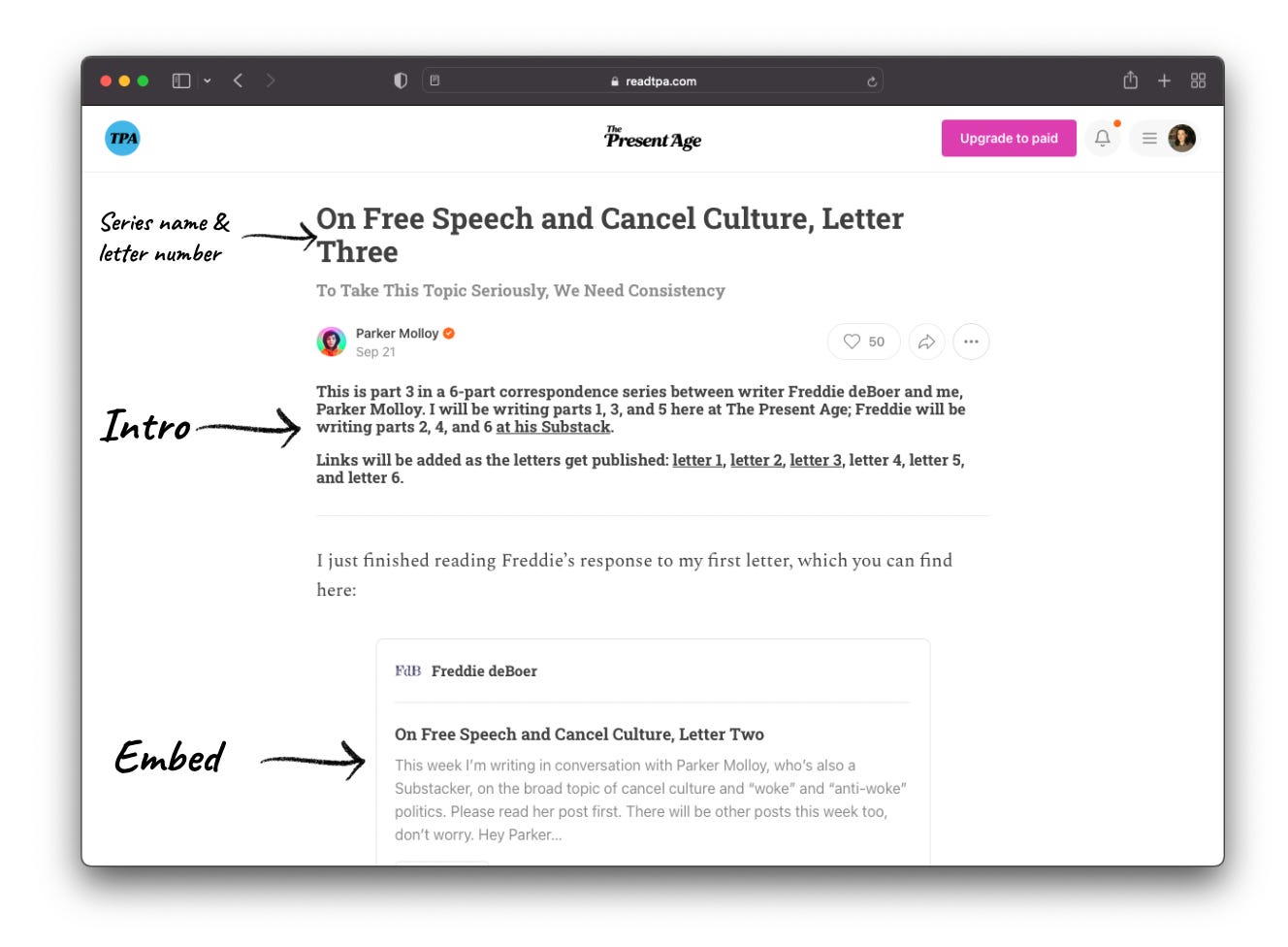Writers and creators collaborating with and cross-promoting one another have been the key to discovery on the internet since its inception, notably in the blogosphere, where writers’ blogrolls helped unearth niche communities and build bonds of trust between writers.
The Substack network is deeply influenced by that ethos. Some of the most powerful ways to grow your Substack are the human-powered tools we’ve built that help creators suggest other creators to their audience via the subscribe flow, on their home pages and profiles, and in their emails.
None of these tools require the creators to be marketing-savvy, and none rely on clickbait or gimmicky packaging, but creators are using them to drive 40% of all free subscriptions and 20% of paid subscriptions across the Substack network.
Check out this summary of Substack’s creator collaboration tools, or keep reading to dive deeper:
Guest posts
Any writer, on or off Substack, can be added as the guest author of a post. Now, you can simply click the “+” sign under the post title and search for the name of any writer on Substack. If the writer isn’t on Substack yet, enter their email to send them a guest post invite.
The guest byline will display prominently at the top of the post, shining a spotlight on them so that readers can learn about their work and easily subscribe to their publication. Additionally, the post will be listed in their Substack profile.
Here are some guest collaborations we’ve spotted:
While on maternity leave, cook and author
invited friends to share their recipes on her publication, . shared her butternut squash salad recipe, and cooked up a tortilla scramble.Culture critic
invited emerging writer to publish an essay called My Fistulous Body as part of a rotating series onThe authors behind
by invited to write a post about her family bakery’s experience with controversy in a small Ohio college town.
Podcast guests
You can use the guest post tools in a podcast episode post to point listeners to your podcast guest’s profile or publication. If your guest loved the conversation, you can also encourage them to cross-post the episode to their own subscribers on Substack.

Learn more: How can I add a guest author to a post?
Collaborative live videos
Creators can invite anyone with the Substack app to join collaborative live videos, providing exposure to new audiences and enabling spontaneous, engaging broadcasts. Currently, streaming is available to bestsellers in the iOS and Android apps, with plans to roll it out to all users soon.
When you go live, your subscribers are immediately notified. After the livestream, the recording is automatically saved as a draft for your next post and you can also use the clipping tool to share highlights on Notes and other social channels.
Political journalists
and teamed up for a live breakdown of the presidential debate, while lifestyle creators and discussed the highs and lows of life in your 40s. If your collaborator isn’t on Substack yet, they just need to create an account.
Disclaimer: Streaming is now available to bestsellers on the iOS and Android apps, with plans to roll it out to all creators in the coming months. If you’re not a bestseller but want early access to streaming, you can request it here.
Learn more: Getting started with live video
Cross-posts
Cross-posting provides a seamless way to share another publication’s post with your audience. You can add your commentary to introduce the post and then share it directly with your audience via email.
Writer and editor
reposted the latest episode of The Active Voice, where she received a shoutout from .You might use cross-posts to share a post or podcast you were featured in or were the guest author of, to amplify a favorite post episode you think will resonates with your readers, or to celebrate the announcement of a writer you love who’s starting a Substack.
Learn more: How can I share another publication’s post with my subscribers?
Mentions
Mentions enable writers to easily promote other writers who are publishing interesting work. Simply search and tag writers and publications within the Substack network from the editor using the “@” key. The writer will be notified when they are mentioned.
Author
used a mention to tell the delightful story of how illustrator serendipitously created a new logo for after a conversation in Chat.You can even mention readers and honor their contributions to your work. Food writer
thanks reader for his gummy bear flavor suggestion, which inspired his latest post. Fellow readers can hover over the mention to discover other great publications.Learn more: Can I tag a writer or Substack publication in a post?
Notes
Notes is a natural home for collaboration—writers and readers can recommend posts, links, images, and quotes, leave comments, and more. Notes is a space where writers can publish short-form posts and share ideas with each other and their readers. Learn how writers collaborate in Notes:
A guide to growth and collaboration on Substack Notes
How to engage with others and promote your publication
Host a Letter exchange
The most strategic approach for growing your publication is to work with other writers, podcasters, and publishers who have some audience overlap; for example, someone who writes on the same topic but has a different angle from your work, and thus a slightly different audience. One way to pitch a guest post with another writer is to suggest a letter exchange about a topic that intrigues you both.
Once you’ve agreed to do a letter exchange with another writer, here are the next steps to iron out.
Pick a topic. What question do you wish to address in the conversation? Picking a question where you might not agree with another writer can lead to more interesting conversations.
Name the series. The job of the series name, or title, is simple: to make people want to read your exchange. Think of your title as the hook to stop people in their busyness. A good title is brief. After you write it once, try chopping it in half again before you hit publish. For example,
Parker Molloy and Freddie deBoer titled their exchange On Free Speech and Cancel Culture. Each exchange they hosted uses the title “On Free Speech and Cancel Culture” followed by the number of the letter.
Decide on a cadence. We recommend one letter per week from each writer; for example, one writer shares on Mondays and the other responds on Thursdays for three weeks. Agree on who will write the opening letter and who will have the last word.
Write your letters. To help readers understand the letter concept and orient themselves within the conversation, each title should include the letter number. Posts should include a short introduction and an embed of the preceding post in the conversation.
What makes a good collaboration?
A meaningful collaboration has a few key components:
Collaboration is an extension of trust. You are making a personal recommendation, and that is powerful. The best collaborations are with other writers, podcasters, and publishers who you respect and want to be associated with.
Collaboration starts with relationship building. Start small by getting curious about other writers—follow their work, leave comments, reply directly to their Substack email without an ask but just to tell them what you liked about their writing or thinking. Elizabeth Held, who writes What To Read If, calls this “gentle outreach,” and she grew her list from 0 to over 2,000 in her first year by building relationships. Keep reading.
Collaborate with people who are similar in one audience, topic, or format but not all the same. How can you bring a new angle or perspective to a slightly different audience? @Brian Klass, author of The Garden of Forking Paths, suggests, “The best ideas, I’ve found, emerge when writers plant that knowledge somewhere a little different, an economist who brings game theory to sports, a poet who writes about politics, or a journalist who, every so often, looks inward and makes themselves the focus of their story. Take what you know and introduce it to something you don’t.” Keep reading.
Timing cross-promotion with something newsworthy can add extra fuel to your growth. When there is something newsworthy happening that overlaps with your expertise, it’s a great time to pitch writers and podcasters on a collaboration. That includes what’s newsworthy to you personally: if you are celebrating a milestone with your Substack, like a year of writing, launching paid subscriptions, or a new post series, that’s another opportunity to get in front of people.
Build excitement for upcoming collaborations. Whether it’s a guest post, podcast appearance, or live video, planning ahead can generate additional interest for your collaboration. Promote it on Substack and social media, giving your audience a heads-up and setting expectations. Afterward, share highlights on X, Instagram, and Notes to engage non-subscribers and encourage future participation.
Make collaborations part of your routine. Regular collaborations help deepen engagement and drive growth. Establish a consistent cadence to build anticipation and highlight the unique value you’re providing.
Who are you dreaming of collaborating with? Let us know in the comments, and perhaps you’ll even find your next collaborator there.














Share this post